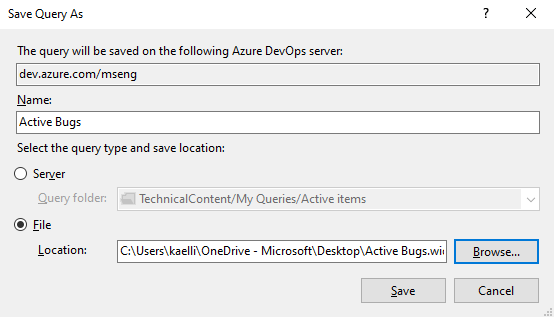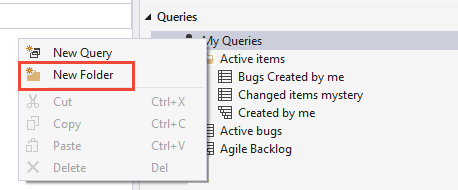Manage and organize queries in Azure Boards and Azure DevOps
TFS 2018
Visual Studio 2019 | Visual Studio 2022
Organize your personal or shared queries by adding a query folder. You can then add queries to or move existing queries into those folders. You can create queries and query folders from the web portal or from a supported client, such as Visual Studio Team Explorer.
Note
To create and manage queries in Visual Studio 2019, you need to Set the Work Items experience to the legacy option. Also, you can perform bulk drag-and-drop of queries into query folders from Visual Studio but not from the web portal.
Prerequisites
- By default, all project members and users with Stakeholder access can view and run all shared queries. You can change the permissions set for a shared query folder or shared query. For more information, see Set query permissions.
- To add and save a query under Shared queries, you must be granted Basic access or higher. Also, you must have your Contribute permission set to Allow for the folder you want to add the query to. By default, the Contributors group doesn't have this permission.
Open a query
From your web browser, open Boards > Queries.

Run, edit, and save a query
The easiest way to define a query is to start with an existing shared query. The following example shows how to find all closed bugs by modifying the Active Bugs shared query provided with the Agile process template. Examples are based on the user interface provided through the web portal.
Open a shared query. For example, from the web portal, open the Active Bugs or similar flat list query.

Tip
If you're working in Visual Studio Team Explorer, open the Work page to access your queries and shared queries. If Team Explorer isn't visible, choose View>Team Explorer from the top level menu.
Edit the query to find closed bugs and then run the query. Use
 to insert a clause above the current clause. Use
to insert a clause above the current clause. Use  to delete a clause. Queries are automatically scoped to the current project. To find work items defined in several projects, see Query across projects.
to delete a clause. Queries are automatically scoped to the current project. To find work items defined in several projects, see Query across projects.
Save the query to your My Queries folder.

To save a query to the Shared Queries folder, you need to be a member of the Project Administrators group, or have your Contribute permissions on the folder set to Allow. For more information, see Set query permissions.
Rename or delete a query
Choose the ![]() context menu icon of a query to edit, rename, or delete the query.
context menu icon of a query to edit, rename, or delete the query.

Add a query folder and move items into a folder
Tip
You need Delete permissions to rename or move a shared query or folder, and Contribute permissions for the folder where you move the query to. To view or set permissions, see Set permissions on queries and query folders.
You add query folders from the Boards>Queries page.
To add a folder, choose the
 context menu for an existing folder or the top container folder and select New query folder.
context menu for an existing folder or the top container folder and select New query folder.Enter the name for the folder in the New query folder dialog.

To move items into a folder, drag-and-drop a query onto the folder. From the web portal, you can only drag a single query from outside a folder into a folder.
Optionally, you can choose the
 context icon for an existing query and choose Rename. In the Rename query dialog, select the folder you want to save the query in.
context icon for an existing query and choose Rename. In the Rename query dialog, select the folder you want to save the query in.
Save a query as a team favorite
To save a shared query as a team favorite, you must be a member of the team.
To add a query to a dashboard, open the ![]() actions icon (or
actions icon (or  context icon) menu for the query and add it to a specific dashboard or as a team favorite.
context icon) menu for the query and add it to a specific dashboard or as a team favorite.
Share queries with your team by adding them to a folder under the Shared Queries container. To save a query to a Shared Queries folder, get added to the Project Collection Administrators group or have your permissions set for a folder under Shared Queries.
You can only add shared queries to dashboards or as team favorites, and only if you have team administrator or project administrator permissions.
To save a query as a team favorite, open
 More actions or
More actions or  the context menu for the query from the Queries page.
the context menu for the query from the Queries page.Choose Add to team favorites, and then select from the teams listed. Only teams for which you're a member are listed.

Add a query tile to a dashboard
A query tile displays a count of the work items in a query. You can also quickly open the query from the dashboard. You can add a query tile to a dashboard from the Queries page using the following steps, or by following the steps outlined in Add widgets to a dashboard.
Note
You can only add a shared query to a dashboard. And, to add or edit a widget of a team dashboard, you must be a member of the team or be granted permissions to edit the dashboard.
To add a query to a dashboard from the Queries page, open the
 actions icon (or
actions icon (or  context icon) menu for the query.
context icon) menu for the query.
From the Select a dashboard dialog, choose the dashboard you want to add the query to.

Open the dashboard, and verify the query tile was added. You can configure the query tile to change the default color and to specify the color for the tile based on a conditional rule you specify.






